Catherine Shuttleworth
Sep 25, 2023

Scientists discover two new celestial objects in our galaxy
Potential polar ring galaxy NGC 4632. The picture shows a gaseous ring perpendicularly circulating the main spiral disk of the galaxy. [Credit: Jayanne English (U. Manitoba), Nathan Deg (Queen's U.) & WALLABY Survey, CSIRO / ASKAP, NAOJ / Subaru Telescope]
Two potential polar ring galaxies, described as a strange celestial object, have recently been discovered by a team of astronomers.
A polar ring galaxy possess a ring of stars and gas that's oriented 90 degrees to other stars in the realm as well as its main disk.
The potential finding implies that polar ring galaxies may not be as rare as once thought by scientists.
"Polar ring galaxies are some of the most spectacular looking galaxies in the universe,' Nathan Deg, team co-leader and Queen's University researcher, said in a statement. "These findings suggest that one to three percent of nearby galaxies may have gaseous polar rings, which is much higher than suggested by optical telescopes."
The two galaxies have been labelled NGC 4632, located around 56 million light years from Earth in the constellation of Virgo, and NGC 6156, located around 150 million light-years away in the constellation of Ara. The ring features of the two galaxies are hidden in visible light, and not visible to the human eye, due to the incorporation of light beyond the visible light spectrum, such as radio light from cold hydrogen gas. But they are revealed in radio observations.
The rings of stars and gas that surround the galaxy are believed to form during mergers in which a larger galaxy swallows a smaller one. The gravitational influence of one galaxy drags a stream of matter from the other. If polar ring galaxies are more common than originally thought, this means these mergers are also more frequent.
By studying the polar ring galaxies, it may help scientists understand more about dark matter; a mysterious substance that is invisible to us yet accounts for around 85 per cent of the matter in the universe.
"These results are a really nice illustration of the tremendous value of mapping the sky more deeply and more widely than has ever been done before," Kristine Speakers, research co-leader and Queen's University scientist, said in the statement. "This is serendipity at its best: we found things we certainly didn't expect to find."
Jayanne English, a University of Manitoba scientist and member of the discovery team, shared that she used the data to "assign multiple colours [...] to subtly convey the motion happening within the polar ring."
Colour gradients within the rings are useful because they show the different orbital motion of the gas, with purple regions at the disk's base showing areas moving towards Earth, while white regions at the peak of the disk move away from us.
"... that motion of the gas gives us some clues as to how galaxies evolve over time," English concluded.
The next step for researchers is to confirm that these are indeed polar ring galaxies by investigating NGC 4632 and NGC 6156 with a wide range of telescopes.
The team’s findings were published Sept. 13 in the journal Monthly Notices of the Royal Astronomical Society.
Sign up to our free Indy100 weekly newsletter
Have your say in our news democracy. Click the upvote icon at the top of the page to help raise this article through the indy100 rankings.
Top 100
The Conversation (0)













